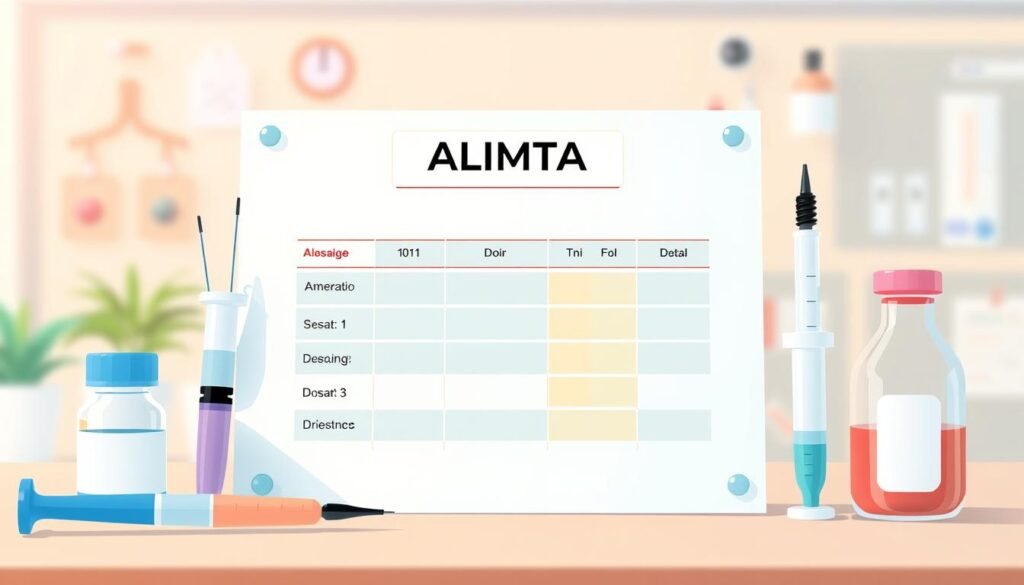Lung cancer is the second most common cancer in the United States. It affects over 230,000 people every year. Alimta, or pemetrexed, is key in treating it, especially for non-small cell lung cancer and malignant pleural mesothelioma. The FDA approved Alimta in 2004. It works by stopping the cancer cells from multiplying, helping patients fight this tough disease.
This guide provides detailed info on Alimta. You’ll learn how it works, when it’s used, and about combining it with other treatments. Knowing these facts can help patients and families tackle lung cancer more effectively. It’s all about being ready for what comes next.
Key Takeaways
- Alimta was FDA-approved in 2004 for lung cancer treatment.
- It is specifically indicated for non-small cell lung cancer and malignant pleural mesothelioma.
- Combination therapy with cisplatin enhances the effectiveness of Alimta.
- Potential side effects include nausea, fatigue, and low blood cell counts.
- Understanding dosage guidelines is crucial for managing treatment safely.
- Long-term use of Alimta can lead to better outcomes in specific patient populations.
Understanding Lung Cancer Types
Lung cancer is split into two main kinds, NSCLC and SCLC. NSCLC is the most common, making up about 85% of cases. It has key types like adenocarcinoma, squamous cell carcinoma, and large cell carcinoma.
Another important but rarer type is malignant pleural mesothelioma. It often links to asbestos exposure and targets the lung’s lining. Knowing the differences between these lung cancer types is key for the right treatment.
Treatment depends on if it’s NSCLC or another form. For NSCLC, chemotherapy is a common treatment. SCLC might need other approaches because it’s more aggressive. Understanding these variations is essential for personalized care.
| Lung Cancer Type | Percentage of Cases | Common Subtypes/Treatment Approaches |
|---|---|---|
| Non-Small Cell Lung Cancer (NSCLC) | ~85% | Adenocarcinoma, Squamous Cell Carcinoma, Large Cell Carcinoma |
| Small Cell Lung Cancer (SCLC) | ~15% | Limited Treatment Options, Often Chemotherapy |
| Malignant Pleural Mesothelioma | Rare | Associated with Asbestos Exposure, Aggressive Treatment Required |
What is Alimta (Pemetrexed)?
Alimta, or pemetrexed, is a leading chemotherapy medicine. It fights some lung cancers. It has a special mechanism of action that stops cancer cells from growing by interrupting their DNA and RNA. Alimta is mostly used for treating non-squamous non-small cell lung cancer (NSCLC) and malignant pleural mesothelioma. It’s an important option for these tough conditions.
Mechanism of Action
Alimta works by blocking important enzymes, like thymidylate synthase and dihydrofolate reductase. These enzymes are crucial for making DNA and RNA needed for cell growth. Alimta turns into a form inside cancer cells that stays longer. This helps it work better and longer against cancer.
Benefits of Using Alimta
The benefits of Alimta are proven. People taking this drug have seen better response rates. They also live longer, especially those with nonsquamous NSCLC and malignant pleural mesothelioma. Compared to other chemotherapy, Alimta might cause fewer side effects. It’s become a key part of treating lung cancer.
Indications for Alimta in Lung Cancer Treatment
Alimta, also known as pemetrexed, is a key player in treating lung cancer. It shows promise for non-small cell lung cancer (NSCLC) and malignant pleural mesothelioma. These cancers show how effective Alimta can be.
Use in Non-Small Cell Lung Cancer
Alimta is most valuable for advanced or spreading nonsquamous NSCLC. It’s the first choice with cisplatin, backed by many studies. The combination got the green light in September 2008. This approval was a major step forward.
Alimta is also an option on its own after previous chemotherapy. This expands its use in non-small cell lung cancer treatment.
Malignant Pleural Mesothelioma
In treating malignant pleural mesothelioma, Alimta plus cisplatin is a go-to choice. This applies when surgery isn’t possible. Together, they’ve improved patient survival.
The FDA first approved Alimta in 2004 for this tough cancer. Its role is still strong, thanks to ongoing research. Alimta stays essential in treating NSCLC and malignant pleural mesothelioma.
Combination Therapy: Alimta and Cisplatin
The combo of Alimta (pemetrexed) and cisplatin has improved how we treat lung cancer and mesothelioma. It makes treatment more effective and helps patients live longer. These meds are given through an IV every three weeks, for about three to six months.
Effectiveness of Combination Treatment
The combo of alimta and cisplatin works well, as studies show. One study on stage IIIB or IV lung cancer found a 45% response rate. Patients lived an average of 8.9 months. In comparison, using just cisplatin alone wasn’t as effective.
When used together, these drugs do much better than one drug alone, especially for mesothelioma patients.
Clinical Evidence and Approval History
Alimta got the green light from the FDA in 2004 for lung cancer treatment. By 2008, it was also approved to use with cisplatin. The EMPHACIS trial, with 448 patients, showed this combo’s big benefits for those with mesothelioma.
This treatment continues to show good results for patients. Knowing how to safely use these drugs is key for the best outcome. You can learn more about this treatment combo here.
Maintenance Therapy with Alimta
Maintenance therapy with Alimta (pemetrexed) is key in managing advanced non-small cell lung cancer. It starts after four cycles of platinum-based chemotherapy if the cancer hasn’t grown. This method helps delay the cancer’s progression and may help patients live longer.
Criteria for Maintenance Therapy
Choosing who gets maintenance therapy is careful work. It is for those who finished chemotherapy without the disease getting worse. Also, it’s important they are healthy enough for more treatment. A success rate of 46.4% shows it’s beneficial for those who meet the criteria.
Benefits of Long-Term Use
Being on Alimta for a long time comes with big pluses. Studies show it can make life better, letting patients enjoy more time without feeling sick. Some have seen their cancer not get worse for up to 46 months. Most people handle the therapy well, so it not only lengthens life but improves it.
Research shows that staying on pemetrexed can make patients live longer and control the disease in 98.6% of cases. This success helps us keep improving how we treat lung cancer. It’s a step forward in caring for patients.
For more on how pemetrexed helps, look at studies like this case study. It shows why maintenance therapy matters so much.
Dosage and Administration Guidelines
Knowing how to correctly use Alimta (pemetrexed) is key for good outcomes and safety. A common approach is to give 500 mg/m² through an IV every three weeks. For the best results and safety, healthcare professionals need to follow these guidelines closely.
Standard Dosing Regimen
Alimta’s dosing is designed to work well when given every three weeks. It’s important to watch how patients react to treatment. Changes might be needed based on each person’s health, like how well their kidneys work.
We need to be careful with how it’s given to keep patients safe.
Pre-treatment Requirements
Before starting Alimta, there are steps to take. Taking folic acid and vitamin B12 can help avoid some side effects like issues with blood and the stomach. These steps make treatment work better and less harsh.
Also, checking other medicines the patient takes is important. This helps avoid bad reactions, especially kidney problems from drugs like Bacitracin or ibuprofen.

Managing Side Effects of Alimta
Alimta is often used for treating lung cancer. However, it can have side effects that patients need to know about. Being aware of these side effects is key for good care during treatment.
Common Adverse Effects
Side effects from Alimta can affect patients differently. Some common ones to watch out for include:
- Nausea and vomiting
- Loss of appetite
- Fatigue
- Low blood cell counts, leading to anemia and a higher risk of infection
- Skin changes and rashes
- Pneumonitis, causing inflammation of the lungs
Nutritional counseling can help with changes in appetite. It’s important to know that effects, like bad nausea or rashes, need urgent care.
Strategies for Mitigating Side Effects
Managing side effects well can make treatment with Alimta more comfortable. There are several strategies to consider, such as:
- Premedication: Taking corticosteroids before treatment can reduce skin reactions.
- Folic Acid and B12: Folic acid supplements and vitamin B12 shots can lessen side effects from not having enough folate.
- Monitoring: Regular doctor visits help keep track of blood counts and make needed treatment changes.
- Hydration: Drinking plenty of fluids can ease stomach symptoms and help the kidneys.
- Communication: Reporting new or worsening side effects quickly is crucial.
Using these strategies can improve treatment results and patient experience. Managing side effects well helps patients keep their life quality during Alimta treatment.
Patient Considerations and Special Populations
It’s crucial to understand patient needs for Alimta, especially in those with kidney, liver issues, and the elderly. Each group has different challenges. This requires customized treatment plans to guarantee safety and effectiveness.
Renal and Hepatic Impairment
For those with kidney problems, prescribing Alimta needs careful thought. If a patient’s creatinine clearance is under 45 mL/min, they should not use Alimta because of the increased risk of side effects. On the other hand, liver issues don’t usually mean changes in how much Alimta is given. But, it’s still important to regularly check liver health to avoid any problems. These steps help improve treatment results and reduce the chance of negative reactions.
Elderly Patients and Treatment Adjustments
Elderly people often need their treatment plans changed to fit their health needs. They might react more strongly to treatments, so doctors need to watch them closely. Sometimes, the dosage must be changed to keep them safe. Around 30% to 40% of advanced non-small cell lung cancer (NSCLC) patients are considered performance status 2 (PS2). Paying careful attention to them is key.
In the past, PS2 patients were not included in clinical trials. This meant their ability to benefit from certain treatments wasn’t well understood. However, recent research shows they can indeed respond well to therapy options. This includes chemotherapy.

| Patient Group | Considerations | Recommendations |
|---|---|---|
| Renal Impairment | Creatinine clearance | Avoid Alimta |
| Hepatic Impairment | No significant dose modification | Regular liver function tests recommended |
| Elderly Patients | Increased susceptibility to adverse effects | Monitor closely and adjust treatment accordingly |
| PS2 Status Patients | Exclusion from early trials | Consider doublet regimens; monitor outcomes |
Understanding these patient details leads to a better approach in treating lung cancer. This means looking after the varied needs of each patient.
Alimta Lung Cancer: Success Stories
Many alimta success stories show how this treatment helps people with lung cancer. It’s especially effective for a certain type of this cancer, known as non-squamous non-small cell lung cancer (NSCLC). One patient even saw their cancer disappear for six years with the help of pemetrexed, after starting it with other treatments.
Research backs up these stories. One study found that patients on pemetrexed lived a median of 13.9 months longer. This suggests it could be a better option than some other treatments.
One person’s story highlights key points about treating lung cancer. Despite minor side effects, their cancer stayed stable for 18 months. This tells us Alimta can be very effective in certain situations. Yet, this person’s varied treatment history also shows that finding the right approach can take time.
Patients with low levels of specific enzymes and a certain gene change often do better with pemetrexed. This fact points to the importance of tailoring cancer treatment to each person. It’s all about finding what works best for an individual.
In conclusion, these alimta success stories prove that proper care and a detailed treatment plan can lead to incredible results in the fight against lung cancer.
Future Research and Innovations in Treatment
The field of lung cancer treatment is always changing. New methods and therapies are being studied to improve care. Researchers are looking into the benefits of treatments like immunotherapy and targeted therapy. These could be used along with existing treatments like Alimta. This approach aims to better treat non-small cell lung carcinoma (NSCLC).
New Therapeutic Approaches
Clinical trials are key to finding how best to combine drugs. This will make traditional chemotherapy work better. A focus area is the study of EGFR mutations. It’s known that about 15 percent of Canadians with non-squamous NSCLC have this mutation. High rates are seen in people of Asian descent. This fact is guiding researchers to develop customized treatments.
There have been advances in treating patients with tough mutations, like EGFR Exon 20 insertions. These patients usually don’t live as long. The use of therapies like RYBREVANT® with chemotherapy has shown good results. Patients had a median treatment time of around 9.7 months.
Table 1 shows a comparison of treatment outcomes. It looks at different EGFR mutation types and methods of treatment. It shows details like survival rates and how patients responded to various treatments:
| Mutation Type | Overall Survival (OS) Median Month | Progression-Free Survival (PFS) Median Month | Serious Adverse Events (%) |
|---|---|---|---|
| EGFR Wild-type | 24.7 | 5.5 | 37.1 |
| EGFR Exon 20 Insertion | 16.2 | N/A | 37.1 |
| Pemetrexed-based Treatment | Tends to be better than wild-type | 3.0 | 4.6 (fatal adverse events) |
In the future, we hope focused research will improve outcomes for lung cancer patients. Combining advanced and traditional treatments could change the future for many with NSCLC. This could lead to care that’s more effective and tailored to the individual.

Conclusion
Alimta (pemetrexed) plays a key role in treating lung cancer. It is especially vital for those with nonsquamous non-small cell lung cancer (NSCLC) and malignant pleural mesothelioma. With NSCLC making up about 80% of lung cancer cases, the need for effective treatments like Alimta is clear. This guide highlights how Alimta works, its benefits, and its use in combination therapies.
These therapies have shown promising survival rates for advanced-stage patients. Studies show that pemetrexed boosts survival rates in nonsquamous NSCLC when used with platinum-based therapies. Its safety is enhanced when taken with folic acid and vitamin B12 supplements.
This makes Alimta a widely chosen option. Patients find hope knowing they have various treatment choices. As research goes on, we look forward to advancements in lung cancer care.
Understanding Alimta’s benefits and effectiveness gives patients strength. Continued research promises new discoveries and treatments. This keeps hope alive for those facing lung cancer. Innovation and the drive to better patient outcomes lead the way forward.